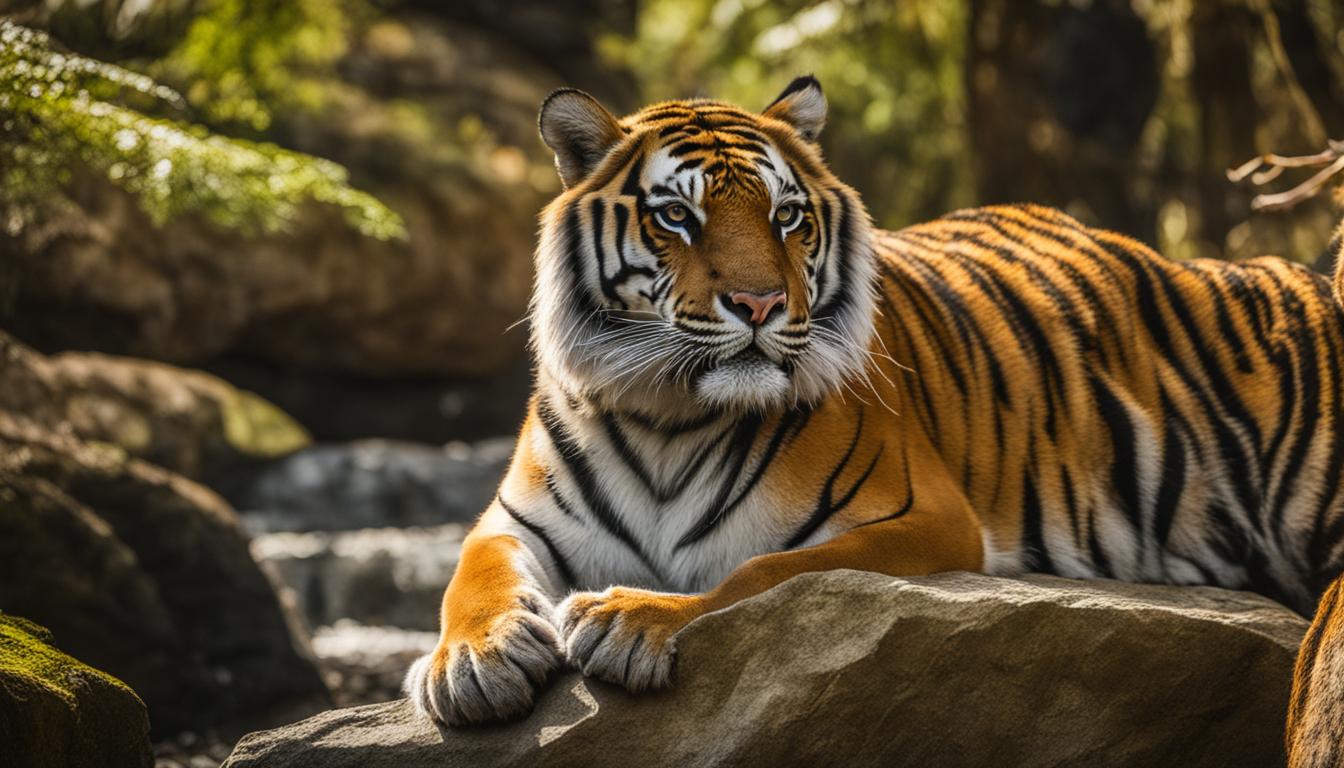Tigers, as majestic predators, have a unique way of coexisting with other predators in their habitat. Understanding their dynamics is essential for promoting tiger conservation and mitigating human-tiger conflict. Let’s explore how tigers manage to share their space with other predators and what it means for their survival.
Key Takeaways:
- Tigers commonly coexist with smaller predators like leopards and dholes.
- Tiger distribution is mainly driven by prey availability.
- Tigers play a crucial role in maintaining ecosystems.
- Conservation efforts should focus on fostering tiger-human harmony.
- Protecting and managing tiger populations is crucial for their coexistence with other predators.
The Role of Tigers in Ecosystem Maintenance
Tigers, as apex predators, play a crucial role in maintaining the balance and health of ecosystems. Their presence ensures the regulation of prey populations, which in turn helps to prevent overgrazing and ecosystem degradation. By preying on herbivores like deer, tigers control their numbers, allowing vegetation to regenerate and ensuring the availability of food and resources for other species.
This symbiotic relationship between tigers and their prey has far-reaching benefits for both wildlife and humans. Sustainable tiger habitats are essential for maintaining healthy ecosystems, as they provide a safe haven for these majestic predators to thrive. Conserving tiger habitats also promotes the coexistence of tigers with other predators, like leopards and dholes, fostering a balanced ecosystem where each species plays its part.
The Importance of Peaceful Tiger-Human Interactions
To ensure the long-term survival of tigers and maintain healthy ecosystems, it is crucial to promote peaceful interactions between tigers and humans. By raising awareness and implementing wildlife conservation strategies, we can educate local communities on the importance of cohabitating with tigers and understanding their behavior. This includes adopting sustainable practices and minimizing activities that may encroach upon tiger habitats or provoke conflict.
Creating sustainable tiger habitats involves preserving and restoring natural landscapes, ensuring the availability of suitable prey species, and minimizing human disturbances. This can be achieved through collaborative efforts between governments, conservation organizations, and local communities, fostering a sense of stewardship and shared responsibility for protecting tigers and their habitats.
| Wildlife Conservation Strategies | Peaceful Tiger-Human Interactions | Sustainable Tiger Habitats | |
|---|---|---|---|
| Definition | Efforts and initiatives aimed at protecting and preserving wildlife species and their habitats | Promoting understanding and coexistence between tigers and humans for a harmonious relationship | Preserving natural landscapes and ensuring the availability of suitable prey to sustain tiger populations |
| Importance | Ensures the survival of endangered species, maintains biodiversity, and preserves ecological balance | Reduces conflicts and threats to human safety while allowing tigers to thrive in their natural habitats | Provides a sustainable environment for tigers to live and reproduce, supporting ecosystem health |
| Methods | Habitat protection, anti-poaching measures, community engagement, and conservation research | Education, awareness campaigns, responsible tourism practices, and land-use planning | Habitat restoration, landscape connectivity, prey management, and sustainable land-use practices |
The role of tigers in ecosystem maintenance is undeniable, and protecting these magnificent creatures is key to safeguarding the delicate balance of our natural world. By implementing effective wildlife conservation strategies, promoting peaceful tiger-human interactions, and creating sustainable tiger habitats, we can ensure a future where tigers continue to roam our planet, enriching our ecosystems and captivating our imaginations.
Tiger Conservation and Habitat Loss
Tigers, majestic and endangered creatures, face numerous threats that have led to a decline in their populations. One of the primary factors contributing to this decline is habitat loss. As human populations expand and encroach upon tiger habitats, the available space for these elusive predators diminishes, leading to increased competition for resources and higher chances of human-tiger conflict.
Fostering tiger-human harmony is crucial for the conservation of these magnificent animals. By managing tiger populations effectively and involving local communities in tiger conservation efforts, we can promote coexistence and ensure the long-term survival of tigers.
The Importance of Managing Tiger Populations
Managing tiger populations is vital to maintaining a healthy ecological balance. Tigers play a crucial role in controlling herbivore populations, such as deer, by preying on them. This helps prevent overgrazing and ecosystem degradation, benefiting both wildlife and humans who rely on the ecosystem for their livelihoods.
However, managing tiger populations requires careful planning and implementation of conservation strategies. It involves studying and monitoring tiger densities, understanding their habitat requirements, and assessing prey availability. By focusing on scientific research and data-driven approaches, we can effectively manage tiger populations and mitigate the negative impacts of habitat loss.
Community Involvement in Tiger Conservation
Engaging local communities in tiger conservation initiatives is essential for their success. By involving communities living near tiger habitats, we can raise awareness about the importance of tiger conservation and foster a sense of ownership and responsibility for protecting these magnificent creatures.
Community-based conservation efforts can include initiatives such as education programs, livelihood support for local communities, and the establishment of protected areas where tigers can thrive. By empowering local communities and providing them with alternative sustainable livelihood options, we can reduce the reliance on tiger habitats for resources and minimize conflicts between humans and tigers.
In conclusion, tiger conservation and addressing habitat loss require a multi-faceted approach that includes managing tiger populations, fostering tiger-human harmony, and involving local communities in conservation efforts. By working together, we can ensure the survival of tigers and create a future where these incredible creatures can coexist peacefully with humans.
Tiger Subspecies and Distribution
Tigers are one of the most iconic and endangered species on our planet. There are several subspecies of tigers, each with its own unique characteristics and distribution. Understanding the different subspecies and their habitats is crucial for effective tiger conservation and coexistence with other predators.
Subspecies of Tigers
Currently, four subspecies of tigers are recognized: the Bengal tiger, South China tiger, Sumatran tiger, and Siberian tiger. Sadly, three subspecies, namely the Bali tiger, Javan tiger, and Caspian tiger, are already extinct. Each subspecies has adapted to specific environments and faces unique conservation challenges.
Current Distribution
Tigers have lost a significant portion of their historical habitat, with around 95% of it gone. Today, tigers only inhabit approximately 7% of their former range. The largest populations of tigers can be found in India and Russia, where conservation efforts are focused. However, smaller populations of tigers can also be found in other Asian countries.
| Subspecies | Distribution |
|---|---|
| Bengal tiger | India, Bangladesh, Nepal, Bhutan, and Myanmar |
| South China tiger | China (extremely rare, if not extinct in the wild) |
| Sumatran tiger | Indonesia (Sumatra Island) |
| Siberian tiger | Russia (Far East region) |
Protecting and managing these tiger populations is of utmost importance for their survival and the conservation of the ecosystems they inhabit. Efforts must be made to safeguard their habitats, address human-tiger conflicts, and involve local communities in conservation initiatives.
Tiger Feeding Ecology and Prey Species
Tigers, as apex predators, have a diverse diet consisting primarily of prey species weighing over 20 kg. Understanding the feeding ecology of tigers and the prey species they rely on is crucial for implementing effective wildlife conservation strategies and addressing human-tiger conflict. By studying the relationship between tigers and their prey, we can gain insights into their coexistence with other predators in their habitat.
Tigers prey on a variety of ungulates, including bantengs, sambar, muntjac, gaur, and wild pig. These large herbivores form the primary food source for tigers, and their abundance directly impacts tiger density and distribution. Prey availability influences the range of breeding females, as well as the survival rates of cubs and juveniles. Therefore, maintaining healthy populations of these prey species is essential for the long-term survival of tigers and their coexistence with other predators.
“The availability of prey is a key factor in determining the density and distribution of tigers. By regulating the population of herbivores, tigers play a vital role in maintaining the balance of the ecosystem,” says Dr. Rachel Johnson, a wildlife biologist.
Conservation efforts should focus on protecting the habitats of prey species, ensuring their populations remain stable and sustainable. By doing so, we can ensure the availability of food sources for tigers and promote their coexistence with other predators in their ecosystem. Addressing human-tiger conflict is also crucial, as it can lead to a decline in prey populations and disrupt the natural balance of the habitat. Through education, community involvement, and sustainable management practices, we can work towards peaceful tiger-human interactions and the conservation of these magnificent predators.
The Prey Species of Tigers
| Prey Species | Common Names |
|---|---|
| Banteng | Wild Cattle |
| Sambar | Large Deer |
| Muntjac | Barking Deer |
| Gaur | Indian Bison |
| Wild Pig | Wild Boar |
Understanding the interdependence between tigers and their prey species is essential for creating effective conservation strategies. By protecting the habitats and populations of these prey species, we can ensure the survival of tigers and promote the coexistence of predators in their natural habitat.
Conclusion
Coexistence between tigers and other predators in their habitat is achievable through a comprehensive understanding of their dynamics and the implementation of effective wildlife conservation strategies. Promoting tiger conservation is vital for preserving these magnificent creatures and ensuring the longevity of their ecosystems.
To achieve peaceful tiger-human interactions, it is crucial to manage tiger populations, protect their habitats, and address the underlying causes of human-tiger conflict. By involving local communities in tiger conservation efforts, we can foster a sense of ownership and responsibility, further strengthening the bond between humans and tigers.
Implementing wildlife conservation strategies is the key to securing the future of tigers and promoting their coexistence with other predators. By controlling prey populations, tigers play a vital role in maintaining ecosystem balance. Therefore, protecting tiger habitats and supporting sustainable tiger-human interactions are essential for the successful conservation of these majestic predators.
What Strategies Do Tigers Use to Coexist with Other Predators in Their Habitat?
Tigers’ coexistence with other predators in their habitat is a result of carefully established strategies. These apex predators employ various survival tactics to minimize conflicts. They allocate territories, establish dominance hierarchies, and communicate through scent marking and vocalizations. Such behaviors foster a balance, allowing tigers to share their space with other formidable predators, including lions’ coexistence with other predators.
FAQ
How do tigers coexist with other predators in their habitat?
Tigers commonly coexist with smaller predators like leopards and dholes. They compete for prey resources, and their habitat use, spatial co-occurrence, prey selection, and activity patterns have been studied to understand their dynamics.
What is the role of tigers in ecosystem maintenance?
Tigers play a crucial role as apex predators in maintaining ecosystems. They help control herbivore populations by preying on species like deer, preventing overgrazing and ecosystem degradation.
How can we promote tiger conservation and peaceful tiger-human interactions?
Promoting peaceful tiger-human interactions and creating sustainable tiger habitats are important strategies in wildlife conservation. It involves managing tiger populations, addressing human-tiger conflict, and involving local communities in conservation efforts.
What are the main threats to tigers and their habitats?
Tigers are listed as endangered due to habitat loss, poaching, climate change, human conflict, and illegal tiger farms. Conservation efforts should focus on protecting tiger habitats and managing tiger populations.
How many subspecies of tigers exist and where are they found?
There are several subspecies of tigers, including the Bengal tiger, South China tiger, Sumatran tiger, and Siberian tiger. Three subspecies – the Bali tiger, Javan tiger, and Caspian tiger – are already extinct. Major populations of tigers can be found in India and Russia, with smaller populations in other Asian countries.
What do tigers feed on and how does it impact their density?
Tigers feed on prey species weighing over 20 kg, and their density is influenced by prey abundance. Understanding the relationship between tigers and their prey is essential in implementing wildlife conservation strategies and addressing human-tiger conflict.











